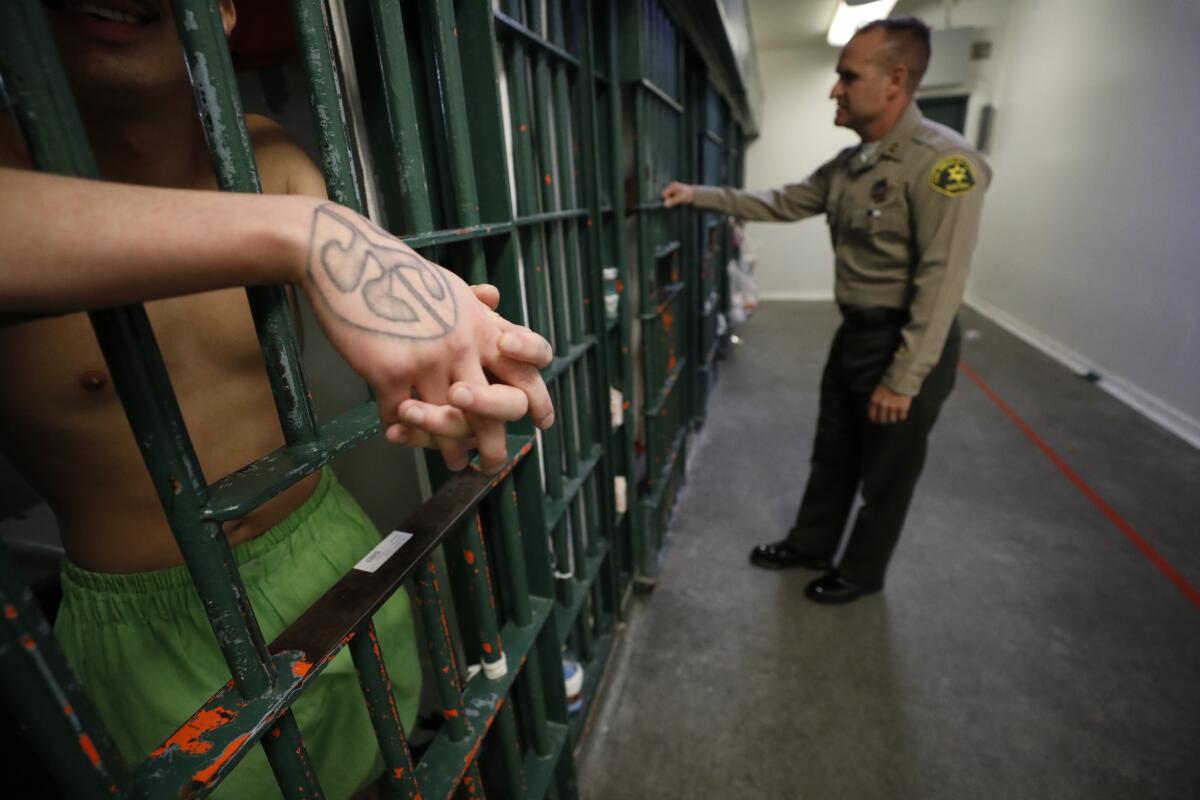Under pressure, Board of Supervisors pulls unpopular motion to decrease jail population

In 2021, in the midst of the pandemic, the Los Angeles County Board of Supervisors approved an ambitious two-year plan to close the dungeon-like Menâs Central Jail. The idea was to decrease the number of people in custody countywide by several thousand and shut down the aging facility bit by bit.
But two years have come and gone, and the total jail population still hovers around 14,000. The notorious downtown lockup â now 60 years old â is still open. And no one seems to agree on a path forward.
This week, the board was set to consider a motion declaring the countyâs jails a âhumanitarian crisisâ and outlining a set of recommendations to help fix that.
But the plan â labeled as a motion to âDepopulate and Decarcerate the Los Angeles County Jailsâ â drew criticism from justice reformers and law enforcement alike. The former said it lacked concrete deadlines for an eventual shutdown of the countyâs most decrepit lockup, while the latter said that what the county really needs is not fewer jails but more modern jails.
So on Monday afternoon â on the heels of several letters, news releases and a rally â Supervisor Hilda Solis pulled the item from this weekâs agenda.
âNever did we once expect for people to come out and pick this thing apart as they did,â she told The Times, adding that she was ânot happyâ about the difficulties moving forward, especially given the troubling recent trajectory of several lawsuits over the countyâs bad jail conditions.
âI chose to move because I am very fearful that we may go into receivership,â she said.
A spokesperson for Supervisor Lindsey Horvath, who co-authored the motion with Solis, did not respond to a request for comment.
The Sheriffâs Department, meanwhile, offered a statement late Monday saying it was still working to assess the impact of the motion and affirming its commitment to addressing the âmany challenges we all face in our jail system.â
As originally proposed, the seven-page motion would have declared a humanitarian crisis in the Los Angeles jails and required the county âto move with all deliberate speed on meaningful solutions.â
One proposed solution involved asking local law enforcement to consider using a cite-and-release system, allowing people to walk free immediately after certain low-level arrests instead of being booked into jail. Another entailed advocating for the elimination of bail on certain low-level offenses â much like the emergency âzero-bailâ schedule used to reduce the jail population for the first two years of the COVID-19 pandemic.
Those suggestions seemed to draw the most attention from parties on both sides of the issues. But the motion also included other ideas, such as finding a different risk assessment tool to evaluate who can safely be released; increasing the use of pretrial release with electronic monitoring; advocating for legislative changes to allow for more compassionate release; and asking the state to transfer people whoâve already been sentenced to prison and now make up roughly 10% of the jail population.
While reform advocates lauded suggestions such as increasing the use of cite-and-release and returning to zero-bail policies, they took issue with expanding the use of electronic monitoring, which they say has failed to reduce jail populations elsewhere.
On Thursday â a day after the motion first went public â Justice LA, a coalition of community organizations, issued a three-page letter of opposition detailing its concerns.
âThis motion does not reflect good governance,â the coalition wrote, calling it a âkitchen sink approachâ to policy. âNoticeably absent from this motion is a concrete timeline for the closure of Menâs Central Jail and benchmarks to measure progress.â
The letter went on to fault the board for not getting community input, failing to recognize the âthreat of deputy gangs,â relying too much on the Sheriffâs Department to implement key components of the plan and not including accountability mechanisms.
âThe Jail Closure Implementation Team was established almost two years ago and there has been no impact on the jail population,â the groups wrote. âIn fact, in that time, conditions in the jail have only become ever more dangerous, as evidenced by the three deaths that occurred in the past 10 days.â
At a rally that same day outside the countyâs Hall of Administration, attorneys, reform advocates and jail survivors spoke to a peaceful crowd about many of the same concerns outlined in the coalition letter.
âThe motion does not adopt the plan put forward two years ago to close the jail,â said Melissa Camacho, a senior staff attorney with the American Civil Liberties Union of Southern California. âThat plan created a road map for the county to be able to close the jail in 24 months. If the county had implemented that plan, rather than moving for a humanitarian crisis, they would be moving to proclaim victory.â
Over the weekend, the Los Angeles County Police Chiefsâ Assn. issued a statement of opposition, and the vice president of the local prosecutors association criticized the motion in an interview with Fox News. On Monday, the Assn. for Los Angeles Deputy Sheriffs released a statement panning the proposal as well.
âThis motion represents a confusing mix of ideas,â Richard Pippin, president of the deputy sheriffs group, said in the statement. âWith regard to their no-jail concept, we all hope that one day there will be a lesser need to incarcerate people, but todayâs reality is that Los Angeles needs modern jails capable of humanely and responsibly housing those who pose a threat to our society.â
Then, minutes before Solis withdrew the motion, Supervisor Janice Hahn waded into the fray, saying she too did not support it.
âI have concerns with this proposal and its potential impact on public safety,â she wrote. âAny plan to reduce the population of our jails needs to be decided in partnership with law enforcement, our deputy district attorneys, and our courts.â
When Solis issued a statement Monday morning withdrawing the motion, she reiterated her concerns about the need to move quickly, given the âhorridâ conditions and pending litigation. The lack of concrete deadlines in the proposal, she said, was because significant population reductions would require cooperation with other elected officials as well as the state.
âThe authority and responsibility to close Menâs Central Jail does not rest solely with the Board of Supervisors,â she wrote. âThe Board of Supervisors has limited jurisdiction and authority over the safe decarceration and diversion of those in County jails, as these authorities lie largely with the Los Angeles Superior Court, the California Department of Corrections and Rehabilitation (CDCR), and the Los Angeles County Sheriff.â
Now, she said, her office will gather more input from stakeholders before finding a path forward.
To Sam Lewis, a former prisoner who is now executive director of the Anti-Recidivism Coalition, the decision to pull the motion represents a loss to people who are currently incarcerated â especially those who are stuck behind bars and donât have a chance to get out with electronic monitoring. The motion, he said, could have opened up that possibility for some of them.
âWas it perfect? No. But we have an imperfect system,â he said. âMaking real substantive change takes a bit of time. Sadly, people that are incarcerated still have to wait.â
More to Read
Sign up for Essential California
The most important California stories and recommendations in your inbox every morning.
You may occasionally receive promotional content from the Los Angeles Times.











